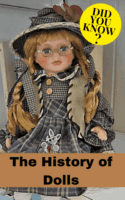Dolls that we love and play with (whether you’re a boy or a girl) actually have a deep history behind them. Dolls were not only used as a child’s toy, but also for magic and religious rituals. Dolls were used in ancient Egypt, Greece and Rome. There is archaeological evidence that dolls were the oldest known toys.
Different types of dolls and the history behind it:
Wooden paddle dolls
Wooden paddle dolls were first discovered in ancient Egyptian tombs in 2000BC. They did not have a specific purpose. The ancient Greek dolls were used as children toys, dating from 100BC. These dolls were found in children’s graves dressed according to the latest fashions. However, newly-wed Greek and Roman girls would give their dolls to Goddess, these dolls had multiple roles, not only were they toys but they were used for rituals and for education.
African dolls and Japanese traditional dolls
African dolls were used for methods of education, messengers of gods and ancestors and ritual tools.
Japanese traditional dolls have long history. They originate from time of ancient Jōmon culture (8000-200 BC). They were used as toys, for protection and in religious ceremonies.
Effigy as a method of performing magic was well known in African, Native American, and European cultures and some of the examples of effigy dolls were European poppets. They often represented persons on which the spell is cast. Sticking pins in voodoo dolls is characteristic of African-American Hoodoo magic while kitchen witch, a poppet originated in Northern Europe, was used as a method for bringing good luck.
The history and origins of dolls
Inuit dolls – these dolls were made from soapstone and bone and dressed in fur.
Apple dolls – these dolls of North Americans which had heads made from dried apples.
Corn husk dolls – these dolls are made from dried corn husk. Corn husk dolls traditionally don’t have faces.
Pennywoods – these were carved wooden dolls and rag dolls made by settlers.
Matryoshka dolls – these were are Russian dolls designed in 1890. They are made from set of similar doll that are hollow and can be put inside each other. They are painted on the outside and varnished. Paint on the outside usually follows the same theme, from fairy tale characters to Soviet leaders.
Clay dolls – these were made in Germany in the 13th century and wooden in the 15th. France of the 16th century made dolls with fashionable clothes but of a simpler design.
Peg wooden dolls – these first appeared in Germany and the Netherlands at about the same time.
Paper dolls – paper dolls were cut out of paper or thin cards with clothes also made from paper. Clothes were made to reflect the modern fashion of the time. Paper dolls that represented famous ballerinas were also the first celebrity dolls. One of the most successful celebrity dolls of the early 20th century were paper dolls of Shirley Temple.
Stuffed toys appeared in 1880. They were made of plush fur-like fabric, unlike ragdolls which were made from simpler fabric. Teddy Bear was manufactured for the first time in 1902 -1903.
Black dolls are dolls made to resemble dark-skinned persons.
Fashion dolls appeared in the mid-19th century and were made from bisque porcelain. The main idea of the fashion dolls was to present modern fashion. An example of a fashion doll is “Barbie” who first appeared on the market in 1959, later in 2001 the Bratz dolls were manufactured.
Action figures, doll toys marketed toward boys appeared in 1964.
Bobbleheads are collectible dolls that were first made from paper-mache, then from porcelain and then from plastic. They have big heads which are connected to the body with a spring or a wire so the head bobbles when it is touched.
At the beginning of the 1990s begins an era of customizable dolls. These dolls are reborn dolls and Asian ball-jointed dolls. The first one is made from vinyl and made to look as close to human babies as possible while the second is much more stylized and inspired by anime but very articulate and poseable.
Today, there are many different types and varieties of dolls for different purposes, dolls are no longer with just one complexion, one style of hair, but have been fashioned to model real-life people with different skin tones.
Tell us: Did you play with dolls as a child?


